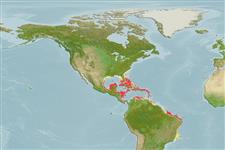Teleostei (teleosts) >
Gobiiformes (Gobies) >
Gobiidae (Gobies) > Gobiinae
Etymology: Elacatinus: Greek, elakatines = fusiform fishes preserved in salt (Ref. 45335).
Eponymy: Evelyn McCutcheon née Shaw (1894–1977) was a writer, psychologist and ichthyologist. [...] (Ref. 128868), visit book page.
More on authors: Böhlke & Robins.
Environment: milieu / climate zone / depth range / distribution range
Ecology
Marine; reef-associated; depth range 1 - 53 m (Ref. 9710), usually 1 - 50 m (Ref. 27115). Tropical; 22°C - 27°C (Ref. 27115)
Western Atlantic: Bahamas and the Lesser Antilles to the northern coast of South America. Also Antilles and western Caribbean (Ref. 26938).
Size / Weight / Age
Maturity: Lm ? range ? - ? cm
Max length : 4.0 cm TL male/unsexed; (Ref. 26340)
Dorsal spines (total): 7; Dorsal soft rays (total): 12; Anal spines: 1; Anal soft rays: 11 - 12. Yellow stripe in front of each eye, joining near tip of snout to form V. Mouth inferior; snout overhangs upper lip, connected by frenum (Ref. 26938). A black stripe beginning on snout, passing through lower part of eye, across upper end of gill opening onto body where it broadens and continues along lower side to end of caudal fin (Ref. 13442).
Inhabits coral reefs with clear waters, preferably in oceanic, insular areas (Ref. 13928). In pairs near coral heads. Monogamous (Ref. 52884). A cleaner (Ref. 9710). Minimum depth reported from Ref. 27115. Has been reared in captivity (Ref. 35420). Feeds on ectoparasites of fishes (Ref. 13442).
Life cycle and mating behavior
Maturity | Reproduction | Spawning | Eggs | Fecundity | Larvae
Monogamous mating is observed as both obigate and social (Ref. 52884).
Böhlke, J.E. and C.C.G. Chaplin, 1993. Fishes of the Bahamas and adjacent tropical waters. 2nd edition. University of Texas Press, Austin. (Ref. 5521)
IUCN Red List Status (Ref. 130435: Version 2024-2)
Threat to humans
Harmless
Human uses
Fisheries: commercial; aquarium: commercial
Tools
Special reports
Download XML
Internet sources
Estimates based on models
Preferred temperature (Ref.
123201): 24.8 - 28, mean 27.3 °C (based on 360 cells).
Phylogenetic diversity index (Ref.
82804): PD
50 = 0.5000 [Uniqueness, from 0.5 = low to 2.0 = high].
Bayesian length-weight: a=0.00724 (0.00339 - 0.01546), b=3.10 (2.92 - 3.28), in cm total length, based on LWR estimates for this (Sub)family-body shape (Ref.
93245).
Trophic level (Ref.
69278): 3.4 ±0.35 se; based on food items.
Resilience (Ref.
120179): High, minimum population doubling time less than 15 months (Preliminary K or Fecundity.).
Fishing Vulnerability (Ref.
59153): Low vulnerability (10 of 100).
Nutrients (Ref.
124155): Calcium = 278 [117, 657] mg/100g; Iron = 1.22 [0.55, 2.55] mg/100g; Protein = 17.8 [15.7, 19.6] %; Omega3 = 0.112 [0.043, 0.268] g/100g; Selenium = 34.1 [12.3, 89.3] μg/100g; VitaminA = 122 [29, 501] μg/100g; Zinc = 3.07 [1.80, 4.86] mg/100g (wet weight);
